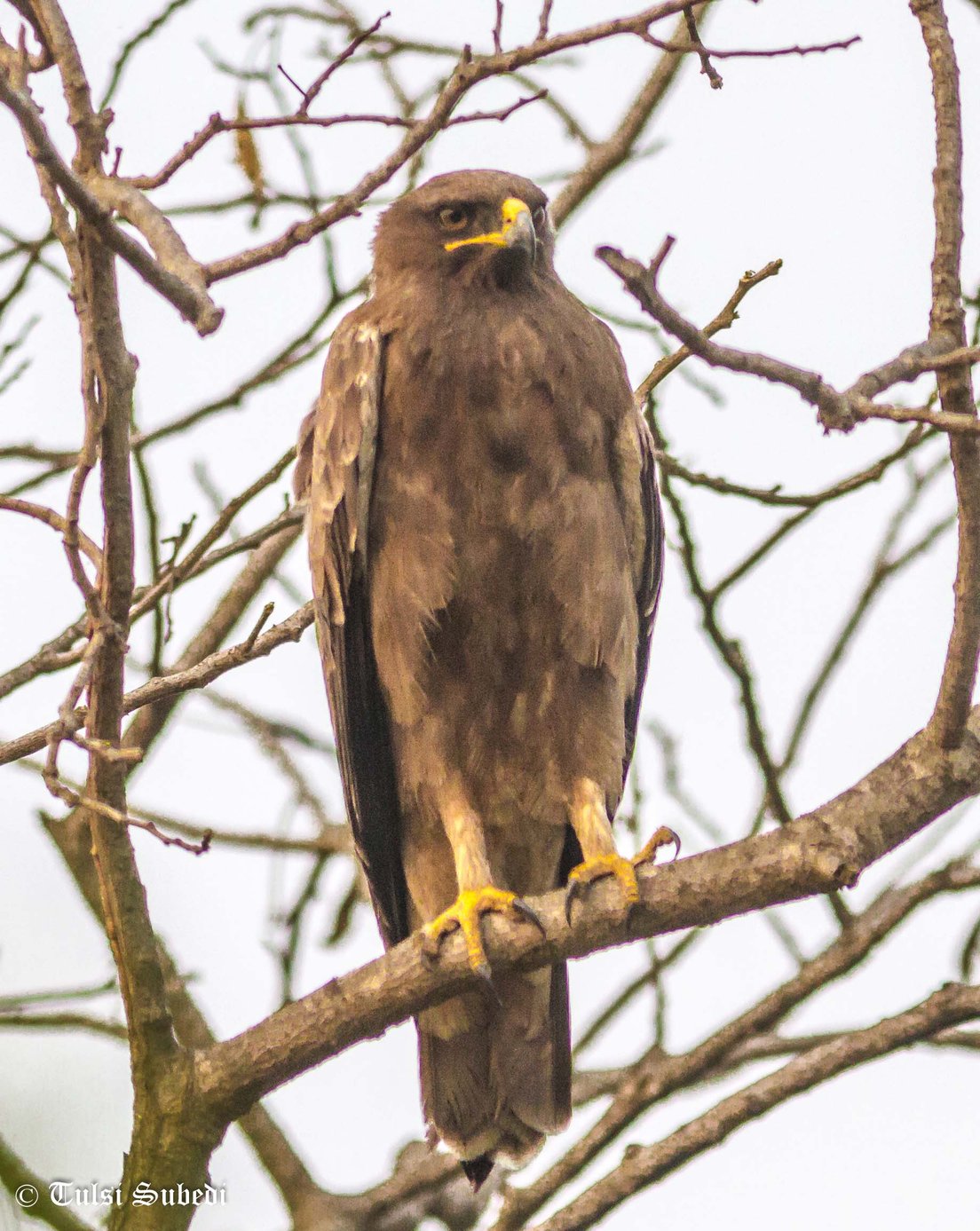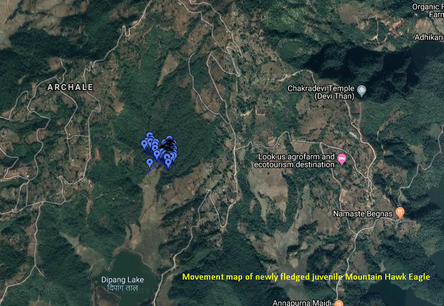Movement study on two rare species of eagle using GPS transmitters in Nepal
May 31, 2019
Raptors are the apex aerial predators and considered as an indicator of environment health. They also provide valuable ecosystem services to the human by controlling the pest animals, cleaning carcasses etc. There are 60 species of day time active raptors known to occur in Nepal, those includes vultures, kites, eagles, hawks, falcons etc. Of those many species, we do not have sufficient information, which is essential to develop conservation and management strategies. Currently we are focusing two species of eagles (Mountain Hawk Eagle Nisaetus nipalensis and Indian Spotted Eagle Clanga hastata) to better understand their breeding biology, home range area, habitat use pattern and major threats. Both the species are the resident species in Nepal.

Indian Spotted EagleIndian Spotted Eagle is a globally vulnerable species and until recently treated as the subspecies of Lesser Spotted Eagle C. pomarina. According to new information the Lesser Spotted Eagle breeds in Europe and winters in Africa while Indian Spotted Eagle is endemic and a scarce resident to the Indian subcontinent occurring in Nepal, India, Pakistan, Myanmar, Bangladesh and Cambodia. In this sense, very little information exists on the ecology of this species. Due to its small population and declining trends, Indian Spotted Eagle is now listed as a vulnerable species in the IUCN Red List. In Nepal this species is considered to be distributed in the lowlands area from east to west Nepal (below 350 m altitude range). They mostly nest in the forest patches and extensively forage over the open area. Nepal population is estimated to be 30 to 70 individuals.
Mountain Hawk Eagle is a large forest eagle distributed into the thick primary forest of the mountains, generally between 1500 to 3000 masl (in Nepal). Globally this species if found in Nepal, India, Sri Lanka, Bhutan, China, Taiwan, Japan, Thailand, Vietnam, Cambodia, Malaysia, Pakistan and Myanmar. We have very little information exists therefore this species can be considered as a data deficient. Current population in Nepal is not known, however this species is classified as a least concern at global as well as national level in Nepal.
Movement information of these species could give valuable information on the major areas of activities. This information can be utilized to identify threats and prioritize conservation strategies. Until today, no systematic study has been carried out to find out their status, distribution and migration ecology in the entire distribution range except in Japan and Taiwan for the Mountain Hawk Eagle. Current knowledge is limited regarding these eagle’s movement; our data from migration count suggest that, they might be migrant species. In addition, there are several questions with no answers until today and those includes; Do they migrate to south at any times of their life? What is their home range size and how they utilize it? What is their habitat requirement? What is the post fledgling behavior? Do they have different home range sizes between males, females and juveniles? What is their land use pattern and how habitat use pattern affects the survival and major activities of the life? These facts are unanswered and we hope to unravel some of the mysteries associated with these species. Our findings are aimed at bringing clearer picture on the status and movement ecology of these eagles in Nepal with implications for their future conservation.
Dr Subedi with an Indian Spotted EagleTo answer above questions, Himalayan Nature is working in Nepal in collaboration with The Peregrine Fund, USA and Kenya Birds of Prey Trust to deploy GPS-GSM transmitters on these majestic eagles. Dr Tulsi Subedi who has recently conducted similar study on Bearded Vulture for his PhD leads this project. Other team members include Dr Hem Sagar Baral, Dr Munir Virani, Dr Ralph Buij, Simon Thomsett and Sandesh Gurung.
In 2018, breeding season (March – Aug) one of the team member (SG) has conducted nest survey and breeding study in several of the territories in lowlands areas of Nepal. This study observed three nests of Indian Spotted Eagle in Lumbini and two nest in the eastern section of Nepal in Koshi Tappu Wildlife Reserve and in Dhanusha district. Similarly, we have discovered one nest of Mountain Hawk Eagle in Dipang and a territory at Thoolakharka at Kaski district. Based on this information, we have chosen Lumbini, Dipang and Thoolakharka as to start this project.
In 2019 (22 - 30 March), Tulsi Subedi and Sandesh Gurung conducted a fieldwork to trap Indian Spotted Eagle in Lumbini and a trip (17-19 April) at Kaski district to identify Mountain Hawk Eagle territories. We were unable to trap any Indian Spotted Eagles at this time however, we learnt their behavior and identified two nests of Indian Spotted Eagle and a nest of Mountain Hawk Eagle. Between 8 – 21 May 2019 we have organized another field trip to catch those eagles. This trip consisted of three members (TS, SG and ST). First (8-14 May) we focused Mountain Hawk Eagle trapping in Dipang and Thoolakharka, and rest of the time we focused catching Indian Spotted Eagle and to put camera traps on nests.
Trapping of Eagle
To capture live birds we have prepared Bal-Chetri (BC) using local materials such as chicken wire and thin metal rods. We prepared two types of BC, first was square shaped with approximately ½ inches messed sized thick wire and second was circular shaped made up from ½ inches messed sized chicken wire and 8 mm metal rod. Entire BC was coated with the thick black paint to camouflage well in the ground. We used pair of small chickens as live bait to trap Mountain Hawk Eagle while either chicken or house rats as live baits for Indian Spotted Eagle. Throughout the upper surface of the BC, 20 lb braided monofilament or 40 lb monofilament nooses were tied. Then the BC was put near the nesting tree so that the bird could easily see baits into the cage. Additionally we used harness with nooses on live chicken to trap Mountain Hawk Eagle.
Capture and Deploy of Transmitter
Researchers deploying a transmitter
In this stage we captured five eagles (Mountain Hawk Eagle – 3 and Indian Spotted Eagle – 2) and deployed 42 grams WT-300 (Gull model) GPS-GSM transmitters (4 units) and OrniTrack (OT 50B-3G) GPS-GSM transmitter (1 unit) with solar panel charger. Korea Institute of Environment Ecology, Korea, developed first models and next was developed by Ornitela Limited, Lithuania. We used Teflon ribbon backpack harness with a leather weak-link to deploy transmitters on them. The weak-link allows the unit to fall down from bird after the lifespan of unit. The harness was attached with the transmitter and the weak-link using aluminum crimps. These units were programmed in 24 hr. duty cycle and to take a GPS location in every two hours. However, when the bird’s flight speed is greater than 20 km/hr. and the battery is sufficiently charged (>95%) these units record locations in every 10 minute. Data were programmed to download twice daily. We also recorded morphometric data. After the deployment of the transmitter, birds were released unharmed. We have already some exciting information coming from those birds.
Monitoring of the Birds and Initial Results
Google map showing movement of the captured bird
After the release of birds with the transmitters, we have monitored them from the computer with the internet access to find out their status and daily movement. Although we need more data to draw conclusion, in this stage we could connect the movement locations of the birds with the google earth to see the movement pattern. Our initial observation showed that the Indian Spotted Eagle used small patches of open forest for nesting and roosting within the area managed by Lumbini Development Trust and extensively foraged in the surrounding Farmscape of Lumbini. As shown by our study, these farmlands are the hub for the pesticides (mainly Organophosphates) use by the farmers.
Similarly, initial data showed, Mountain Hawk Eagle extensively used forest habitat. Our field observation showed the forest habitat is seriously threatened due to removal of mature trees by local people for firewood and timber. Encroachment of forest area or the expansion of agriculture land and development is another major threat in this eagle’s habitat. Additionally we observed extensive coverage of powerlines with uninsulated wires throughout the foraging area of these eagles; these might seriously affect these rare eagles. Yet we have to identify other issues that are threatening these apex predatory birds in the landscapes of Nepal.




Future plan
Our planning is to capture more eagles in the future and do the same, as we require sufficient sample size to generalize our results. Therefore, we request your kind support to find more GPS transmitters to use in the future. Please write to tulsi.biologist@gmail.com if you wish to support us.
For this study, GPS transmitters were supported by Korea Institute of Environment Ecology and and Peregrine Fund/Wageningen University & Research partnership. Field cost was granted from the Peregrine Fund- USA, Oriental Bird Club- UK, Taiwan Bureau of Forestry. We thank all of our supporters. We also thank Department of National Parks and Wildlife Conservation, Department of Forest and Government of Nepal, Annapurna Conservation Area Project and Lumbini Development Trust for the permits to conduct this study.